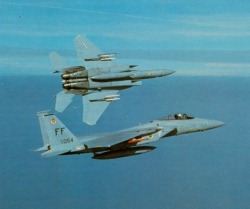|
Excerpt
from Commander Ward's book "Sea Harrier over the Falklands"
|
||||
|
The Boss of the Aggressors was rather upset by the incident, but his staff did get in touch with me by phone to say that the report was a good one, and valid. A few days later, the telephone on my desk at Yeovilton rang "Good morning, Sir. This is the F15 Eagle Squadron at Bitburg in Germany. Could I speak with Commander Sharkey, please?" "Certainly! Speaking!" "Sir, I hear you had a good experience against the Aggressor Squadron at Alconbury, recently. Is that correct?" "Yes. that's right." "Well, Sir, if you"re happy with the idea we'd be delighted to come across to Somerset to do some combat with you. We'd bring over four F15s to see how you get on against Our jet. We hear you did pretty good against the Aggressors." "That would be splendid!" I replied. "We would love to see you here at Yeovilton and to fly with you. Just let us know when you expect to arrive and we'll be at your pleasure for the duration."
 Word had got around fast and the elite of the USAF in Europe couldn't resist the chance to see how good the SHAR was - and whether Alconbury was just a flash in the pan. True to their word, the Bitburg boy, arrived at Yeovilton with four of their magnificent fighters for a day's Air Combat Manoeuvring. It was agreed that the aircraft should operate in pairs against each other , which brought fighter tactics really into play (as opposed to just matching aircraft for aircraft, pilot for pilot (in a 1-v-1 fight). The visitors were fully equipped with their radar and were simulating Sparrow AIM-7E missiles, Sidewinders and guns. The SHARS were without radar but were fitted with their radar warning receivers and were simulating Sidewinders and guns. The two combat sessions were set up over North Devon and the Bristol Channel, with the dissimilar pairs running in towards each other from a distance of about 40 nautical miles. My team were given radar direction from ground radar by a brilliant Direction Officer of many years' experience named Harry O'Grady Having spent years flying the Phantom and using the Sparrow missile, which has an excellent head-on firing capability, I knew how to deny the F15 a valid Sparrow shot from head-on and had briefed my pilots accordingly. The tactic worked well. There were no head-on claims from the F-l5s as they ran in and, as the two aircraft types entered the same airspace, fully developed combat began. Initially, the F-15s had the advantage. Their radars pinpointed the SHARs and directed their pilots' eyes on to the smaller jets. The SHARs flew at about 12,000 feet, which was where we wanted to meet the opposition, and so the F-15s came in from very high level (30.000 feet plus). rolling over and looping down towards the stem of our Sea Jet formation This was when the SHAR was most vulnerable. It was essential that visual contact was made. Morts came to the rescue. |
 "High in the 6 o'clock, Boss! Break port and up! They are about 3 miles and closing fast!" The aircraft shuddered in the hard turn with the nose rising to meet the threat. "Tallyho! On both! I'm flying through the right-hand man and reversing on him. Your tail is clear." The nose of the SeaJet passed through the vertical` with my head strained round as far as it would go to keep tabs on the F-15 which, feeling threatened. had engaged burners and had also pulled vertically upwards and over the top (about 5000 feet above me) As the F-15 came down the other side of the vertical manoeuvre he found me still pointing at him all the way. Trying the same move twice was not a good idea` but that's what he did. I predicted the move, sliced my nose early through the vertical and found myself sitting astern the two white-hot plumes at the back of the US fighter. "Fox Two away!" I called, simulating the release of the Sidewinder missile. Morts fared just as well. The detailed post-flight debriefs showed a 7 to 1 valid kill claim by the SHARs. The Alconbury experience had been no flash in the pan. The Sea Harrier had really arrived on the fighter combat scene. Ed. Note: a version of the sea harrier has been adapted by the USAF and designated AV8A.
FRS1 Reconnaissance Strike Fighter The Sea Harrier FRS1 was developed from the land based Harrier GR1. It was first flown on 20th August 1978, and entered service in 1980 upon the commissioning of the Royal Navy's first STOVL carrier HMS Invincible. Although developed from a ground attack aircraft the Sea Harrier proved itself in the air-to-air role during the Falklands War where it scored several kills against Argentinean aircraft with newly acquired Sidewinder missiles.
Join a discussion forum on this article by clicking HERE.
|
|||
|
Copyright © 1997 - 2000 COMBATSIM.COM, INC. All Rights Reserved. Last Updated February 20th, 1998 |
||||
